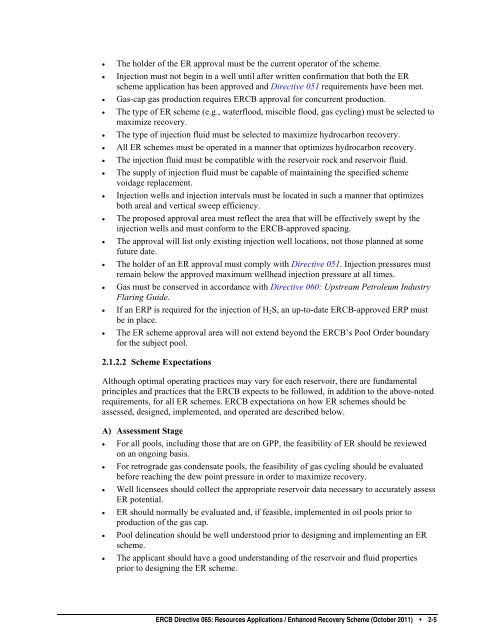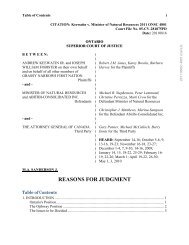Directive 065: Resources Applications for Oil and Gas Reservoirs ...
Directive 065: Resources Applications for Oil and Gas Reservoirs ...
Directive 065: Resources Applications for Oil and Gas Reservoirs ...
Create successful ePaper yourself
Turn your PDF publications into a flip-book with our unique Google optimized e-Paper software.
• The holder of the ER approval must be the current operator of the scheme.<br />
• Injection must not begin in a well until after written confirmation that both the ER<br />
scheme application has been approved <strong>and</strong> <strong>Directive</strong> 051 requirements have been met.<br />
• <strong>Gas</strong>-cap gas production requires ERCB approval <strong>for</strong> concurrent production.<br />
• The type of ER scheme (e.g., waterflood, miscible flood, gas cycling) must be selected to<br />
maximize recovery.<br />
• The type of injection fluid must be selected to maximize hydrocarbon recovery.<br />
• All ER schemes must be operated in a manner that optimizes hydrocarbon recovery.<br />
• The injection fluid must be compatible with the reservoir rock <strong>and</strong> reservoir fluid.<br />
• The supply of injection fluid must be capable of maintaining the specified scheme<br />
voidage replacement.<br />
• Injection wells <strong>and</strong> injection intervals must be located in such a manner that optimizes<br />
both areal <strong>and</strong> vertical sweep efficiency.<br />
• The proposed approval area must reflect the area that will be effectively swept by the<br />
injection wells <strong>and</strong> must con<strong>for</strong>m to the ERCB-approved spacing.<br />
• The approval will list only existing injection well locations, not those planned at some<br />
future date.<br />
• The holder of an ER approval must comply with <strong>Directive</strong> 051. Injection pressures must<br />
remain below the approved maximum wellhead injection pressure at all times.<br />
• <strong>Gas</strong> must be conserved in accordance with <strong>Directive</strong> 060: Upstream Petroleum Industry<br />
Flaring Guide.<br />
• If an ERP is required <strong>for</strong> the injection of H 2 S, an up-to-date ERCB-approved ERP must<br />
be in place.<br />
• The ER scheme approval area will not extend beyond the ERCB’s Pool Order boundary<br />
<strong>for</strong> the subject pool.<br />
2.1.2.2 Scheme Expectations<br />
Although optimal operating practices may vary <strong>for</strong> each reservoir, there are fundamental<br />
principles <strong>and</strong> practices that the ERCB expects to be followed, in addition to the above-noted<br />
requirements, <strong>for</strong> all ER schemes. ERCB expectations on how ER schemes should be<br />
assessed, designed, implemented, <strong>and</strong> operated are described below.<br />
A) Assessment Stage<br />
• For all pools, including those that are on GPP, the feasibility of ER should be reviewed<br />
on an ongoing basis.<br />
• For retrograde gas condensate pools, the feasibility of gas cycling should be evaluated<br />
be<strong>for</strong>e reaching the dew point pressure in order to maximize recovery.<br />
• Well licensees should collect the appropriate reservoir data necessary to accurately assess<br />
ER potential.<br />
• ER should normally be evaluated <strong>and</strong>, if feasible, implemented in oil pools prior to<br />
production of the gas cap.<br />
• Pool delineation should be well understood prior to designing <strong>and</strong> implementing an ER<br />
scheme.<br />
• The applicant should have a good underst<strong>and</strong>ing of the reservoir <strong>and</strong> fluid properties<br />
prior to designing the ER scheme.<br />
ERCB <strong>Directive</strong> <strong>065</strong>: <strong>Resources</strong> <strong>Applications</strong> / Enhanced Recovery Scheme (October 2011) • 2-5
















